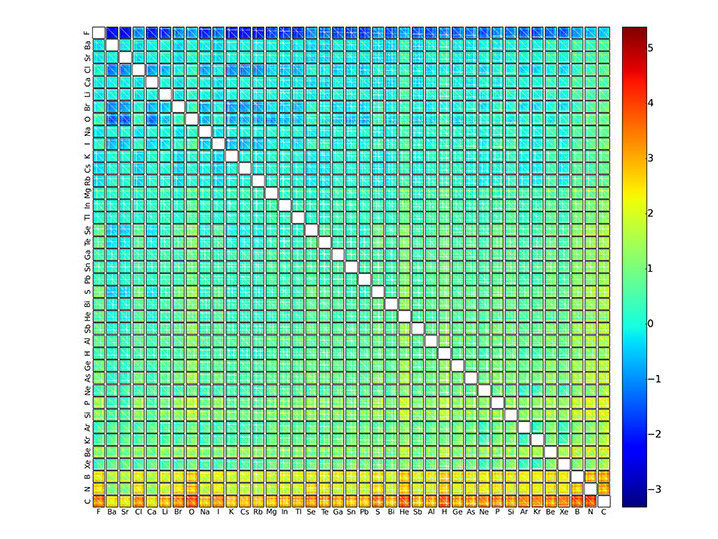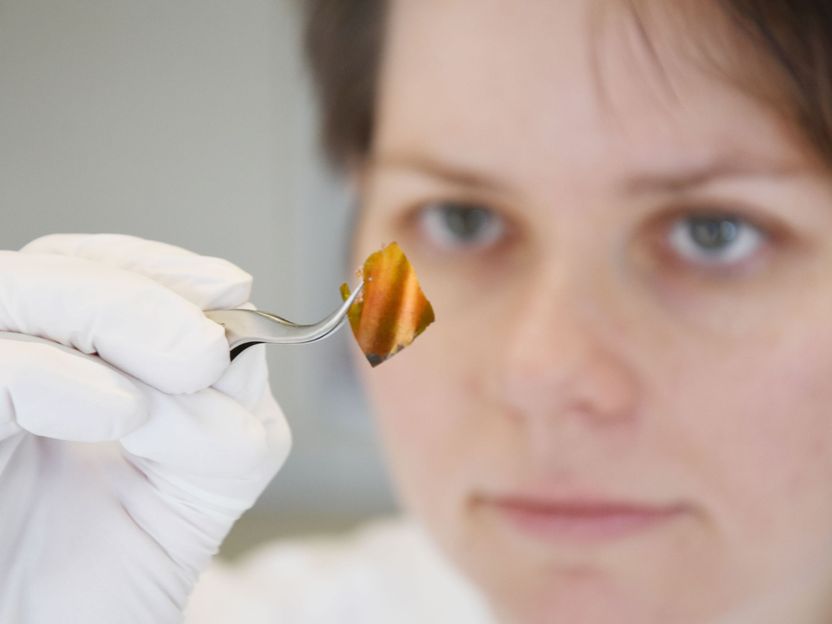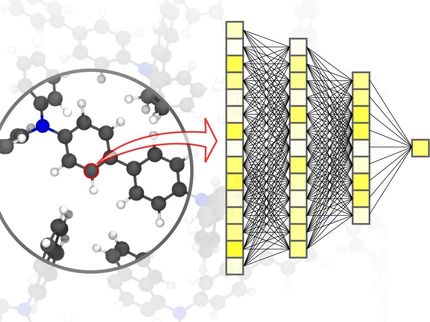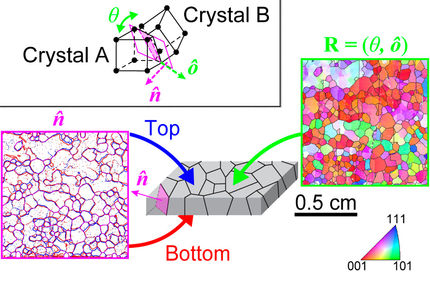Artificial intelligence helps in the discovery of new materials
With the help of artificial intelligence, chemists from the University of Basel in Switzerland have computed the characteristics of about two million Crystals made up of four chemical elements. The researchers were able to identify 90 previously unknown thermodynamically stable crystals that can be regarded as new materials.

The matrix depicts the formation energy – an indicator of stability – of around two million possible compounds. Each pixel corresponds to one of the two million quaternary crystals. Depending on the combination of elements, they display either a high (red) or low (blue) energy value. One element is specified vertically and one horizontally; each box contains a suitable resolution for the two remaining elements.
Universität Basel, Departement Chemie
Elpasolite is a glassy, transparent, shiny and soft mineral with a cubic crystal structure. First discovered in El Paso County (Colorado, USA), it can also be found in the Rocky Mountains, Virginia and the Apennines (Italy). In experimental databases, elpasolite is one of the most frequently found quaternary crystals (crystals made up of four chemical elements). Depending on its composition, it can be a metallic conductor, a semi-conductor or an insulator, and may also emit light when exposed to radiation.
These characteristics make elpasolite an interesting candidate for use in scintillators (certain aspects of which can already be demonstrated) and other applications. Its chemical complexity means that, mathematically speaking, it is practically impossible to use quantum mechanics to predict every theoretically viable combination of the four elements in the structure of elpasolite.
Machine learning aids statistical analysis
Thanks to modern artificial intelligence, Felix Faber, a doctoral student in Prof. Anatole von Lilienfeld’s group at the University of Basel’s Department of Chemistry, has now succeeded in solving this material design problem. First, using quantum mechanics, he generated predictions for thousands of elpasolite crystals with randomly determined chemical compositions. He then used the results to train statistical machine learning models (ML models). The improved algorithmic strategy achieved a predictive accuracy equivalent to that of standard quantum mechanical approaches.
ML models have the advantage of being several orders of magnitude quicker than corresponding quantum mechanical calculations. Within a day, the ML model was able to predict the formation energy – an indicator of chemical stability – of all two million elpasolite crystals that theoretically can be obtained from the main group elements of the periodic table. In contrast, performance of the calculations by quantum mechanical means would have taken a supercomputer more than 20 million hours.
Unknown materials with interesting characteristics
An analysis of the characteristics computed by the model offers new insights into this class of materials. The researchers were able to detect basic trends in formation energy and identify 90 previously unknown crystals that should be thermodynamically stable, according to quantum mechanical predictions.
On the basis of these potential characteristics, elpasolite has been entered into the Materials Project material database, which plays a key role in the Materials Genome Initiative. The initiative was launched by the US government in 2011 with the aim of using computational support to accelerate the discovery and the experimental synthesis of interesting new materials.
Some of the newly discovered elpasolite crystals display exotic electronic characteristics and unusual compositions. “The combination of artificial intelligence, big data, quantum mechanics and supercomputing opens up promising new avenues for deepening our understanding of materials and discovering new ones that we would not consider if we relied solely on human intuition,” says study director von Lilienfeld.
Original publication
Other news from the department science

Get the chemical industry in your inbox
By submitting this form you agree that LUMITOS AG will send you the newsletter(s) selected above by email. Your data will not be passed on to third parties. Your data will be stored and processed in accordance with our data protection regulations. LUMITOS may contact you by email for the purpose of advertising or market and opinion surveys. You can revoke your consent at any time without giving reasons to LUMITOS AG, Ernst-Augustin-Str. 2, 12489 Berlin, Germany or by e-mail at revoke@lumitos.com with effect for the future. In addition, each email contains a link to unsubscribe from the corresponding newsletter.
Most read news
More news from our other portals
Last viewed contents
Indo-German research collaboration in the field of surface engineering and thin films officially started
Angiotensin_receptor
Asbestos,_Quebec

High-performance combination: Batteries made of silicon and sulphur - Research team of material scientists present an innovative, sustainable energy storage concept

We Wouldn’t Be Able to Control Superintelligent Machines - Would the AI cure cancer, bring about world peace, and prevent a climate disaster? Or would it destroy humanity and take over the Earth?
LyondellBasell to Close LDPE Unit at Carrington, U.K.

Rudolph Logic Systems GmbH - Sarstedt, Germany

Challenging counterfeit products with rare earths - New marking technique could halt product piracy
Merck KGaA and Nano-Terra Announce Extension of Nanotechnology Solutions Alliance





























































